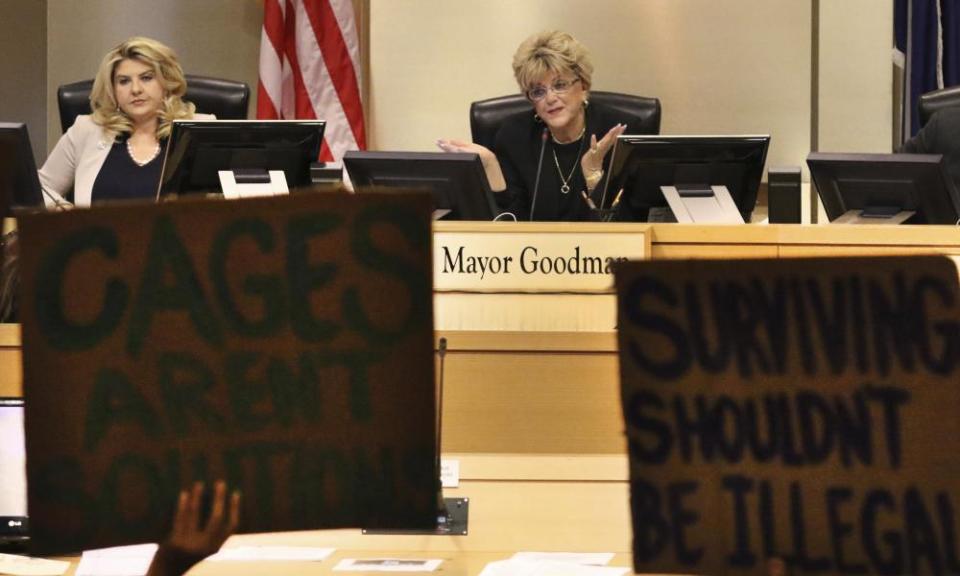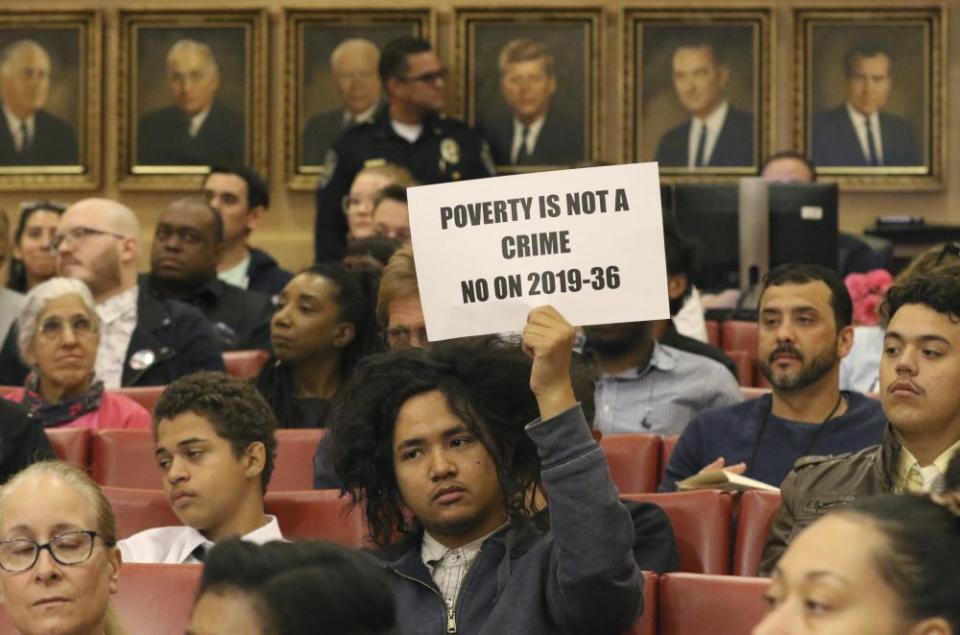'War on the poor': Las Vegas's homelessness crackdown takes effect
Outside a Taco Bell in south-east Las Vegas, Skateboard Mike crossed an empty parking lot and pointed at the tent encampment that had built up on the ledges of a storm drain.
Skateboard Mike, whose real name is Michael Brinkman, lives nearby, spending his nights in a hole he dug in a dirt lot. The space is filled with couch cushions, and Brinkman, 42, usually tops the hole with cardboard and tumbleweed to avoid being exposed.
“It’s not that we’re here. It’s that they see us,” Brinkman said.
Las Vegas recently began cracking down on people living outdoors. In November, the city council approved a law that made sitting, resting or “lodging” on sidewalks a misdemeanor punishable with up to six months in jail or fines of up to $1,000 in most neighborhoods.
“I don’t blame them,” Brinkman said of community support for the ordinance. “That’s where a majority of the homeless people stay, in the wash or the tunnels. As you can see, it becomes an eyesore. Trash is the biggest problem.”
Some say the tipping point in lawmakers’ attitudes was “poop on a stoop”.
Tired of finding human waste outside his office in downtown Las Vegas, attorney Jerry Gillock in September used a shovel to deliver feces to the steps of city hall. Gillock was soon on the 11 o’clock news for the second time in four months demanding action regarding people sleeping, using drugs and relieving themselves outside his law practice.
At the time, the Las Vegas mayor, Carolyn Goodman, was already preparing what may be the most draconian homelessness ordinance in the United States.
The “no lodging” bill passed amid chants from protesters calling “Housing, not handcuffs!” and “Hey-hey, ho-ho, the war on the poor has got to go!”
Goodman instructed city marshals to remove disruptive audience members from the city council chamber.
The law went into effect on 1 January, and enforcement began this month with the caveat that before being fined or arrested, offenders are first asked to relocate to the Corridor of Hope – a district of homeless services tucked in between cemeteries, industrial plants and tow yards – at times when shelters there have beds available. The ordinance is not enforced when homeless shelters are full.
•••
Homelessness is a perennial crisis in southern Nevada, with at least 6,500 people camped on streets or in storm drains, many of them battling addiction. While a transient community at every income level, Las Vegas’s appeal seems particularly strong for people down on their luck. And established residents are susceptible to hard times too, amid the temptations of round-the-clock drinking, gambling and illegal substances.
Related: Las Vegas bans homeless people from sleeping on the street
With no state income tax and dwindling federal support for social services, Nevada has long been ill-equipped to treat problems associated with homelessness. Clark county, which encompasses Las Vegas, recently committed $12m in marijuana tax revenue to homelessness prevention. The city, meanwhile, has invested $20m to increase capacity at the open-air Courtyard Homeless Resource Center. Yet no one is claiming those are adequate solutions.
Las Vegas seems to accept that it’s embarking on a divisive social experiment, one with serious repercussions for displaced people.

“This is flawed but it is a start,” Goodman insisted at the November city council meeting. “We have been having these conversations for 20 years, and we must have results.”
Homeless advocates, however, fear that the “no lodging” convictions will haunt people for the rest of their lives. “It’s going to affect their ability to get student loans, affect their ability to get housing and access public benefits,” Arash Ghafoori of the Nevada Partnership for Homeless Youth told the press. According to its 2019 homeless census, Nevada has the highest rate of homeless youth in the country.
Goodman addressed “those responses that say the city is trying to criminalize the homeless” in her latest State of the City speech, insisting: “Our entire effort is humanitarian and compassionate.” City officials believe the ordinance will force people who refuse housing assistance or treatment services to come off the margins and accept help. Goodman added: “I will not allow the city of Las Vegas to become a skid row harbor of rampant crime and potentially pandemic disease.”
Skateboard Mike Brinkman followed the ordinance debate but didn’t show up to city council meetings. The ordinance, he said, “is all trickle-down effect from the community. It’s really not so much lawmakers or anything.”
Next to a tire shop where Brinkman sometimes works filling air and repairing flats, a woman had built a tarp fort.
“Usually when you go to a town, the homeless stay around the shelters downtown. It’s all isolated to one area,” Brinkman said. “Not here in Las Vegas. They’re everywhere. So I don’t think just one courtyard is going to solve the problem. I think it’s going to have the reverse effect – you’re going to drive them further from trying to receive services.”
•••
The historic Huntridge neighborhood may be the frontline in the city’s fight over homelessness. It has more check-cashing businesses and laundromats than gastropubs and mixology bars, but it borders the trendy East Fremont area, and the ascendant neighborhood’s only green space was recently fenced off for a development project specifically intended to ban homeless people.

Drug use and sex work frequently spilled out of the park, on to surrounding streets. Dan Evans and his wife live one block away and leave an old “decoy car” in their driveway so the home always seems occupied. In the years since the housing crisis, thousands of vacant Las Vegas houses have been damaged by squatters, including on Evans’s street.
“The other half of the Huntridge homeless story is the perpetuation of homelessness by an organization whose members do not reside here,” Evans said regarding Food Not Bombs, a group that drew the neighborhood’s ire by serving free meals in the park twice a week.
“[The homeless] absolutely took over vacant homes, and the police rarely responded,” he added.
•••
Though famous for tolerating bad behavior, Sin City has its limits. Rick Russel, 56, knows that from 11 years sleeping in its alleys and lots. “I can’t go into homeless shelters because I have a problem tearing up people’s property. I feel trapped. Everywhere I go that’s got a roof over my head I don’t like.”
Las Vegas is the first place in which Russel has avoided being institutionalized. On a recent January afternoon, he was scanning the gutters of East Fremont for shiny objects. Women lose jewelry in fights outside the bars, he explained, un-pocketing a gold-colored necklace that had a clip-on earring as its pendant. “Everything I make, I sell. The idea came from, you know, how some of us are broken. All we need is to be picked up and fixed.”
The expansion of the open-air Courtyard shelter seems designed for men like Russel.
He avoids taking prescribed medications for fear of being robbed while asleep, but the Courtyard has storage bins and 24-hour security. And unlike at other shelters, people can check in at any time, regardless of age, gender, or level of sobriety. It even allows pets.
But whether an open-air courtyard meets the definition of “shelter” may ultimately determine the initiative’s fate.
The 9th circuit court of appeals in December struck down a similar ordinance in Boise, Idaho, calling it “cruel and unusual punishment” to fine people for sleeping outdoors while failing to provide enough shelter space to meet their needs.
“As long as there is no option of sleeping indoors, the government cannot criminalize indigent, homeless people for sleeping outdoors, on public property, on the false premise they had a choice in the matter,” Judge Marsha Berzon wrote.
Las Vegas currently has 1,300 shelter beds. The Courtyard offers sleeping mats to lie on cold concrete.
•••
In Las Vegas’s bustling arts district, a vegan taco shop just opened across the street from a new wine bar. Far from being a skid row, the neighborhood’s antique stores, breweries and cocktail lounges increasingly draw tourists away from the Strip. A mural there depicts the mayor with her husband, the former mayor and mob lawyer Oscar Goodman, raising a martini in a toast to the revitalized neighborhood.
The Downtown Vegas Alliance, which represents local businesses, supported the homelessness ordinance as a “necessary first step to help protect those who have made significant investment in the area”. But more than 70% of members surveyed acknowledged that the city lacks the necessary “social or community services to support this ordinance”.
Among those disappointed is Jerry Gillock, the poop-protesting attorney. Standing before the city council during the law’s public comment period, Gillock noted that expanding shelter space did nothing to solve systemic inequalities regarding wages and housing, poor mental health and substance abuse treatment.
“It’s a sham,” Gillock said. “It doesn’t require the city to do anything.”
Brinkman expressed similar concerns, fearing the hardline approach would not inspire people to change.
“I’ll never say I’m homeless. I’m house-less. I’m residentially challenged. Homeless is a behavior to me,” he said, staring off toward the skyline of the Strip. “But here’s the thing: there’s no carrot. There’s no prize, there’s no poster child, there’s no steps to success. No one sees that, and if there’s no carrot, nothing to aim for, you give up. I think that’s where most of the homeless people are. They have just given up.”

